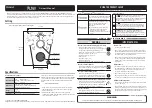
General
OPERATING GUIDE
for use with
PIEZOELECTRIC ICP® ACCELEROMETERS
SPECIFICATION SHEET, INSTALLATION DRAWING AND CALIBRATION INFORMATION ENCLOSED
IMI ASSUMES NO RESPONSIBILITY FOR DAMAGE CAUSED TO THIS PRODUCT AS A RESULT OF
PROCEDURES THAT ARE INCONSISTENT WITH THIS OPERATING GUIDE
1.0 INTRODUCTION
Congratulations on the purchase of a quality ICP®
industrial sensor. In order to ensure the highest level of
performance for this product, it is imperative that you
properly familiarize yourself with the correct mounting
and installation techniques before attempting to
operate this device. If, after reading this manual, you
have any additional questions concerning this sensor or
its application, feel free to call an Application Engineer
at
716-684-0003
or
800-959-4464
.
Proper sensor selection requires special attention to
three main areas: sensor design, dynamic
expectations, and application environment.
Sensor design encompasses the actual sensing
element, the physical material, and component
selection for the sensor. Preferred industrial
accelerometers employ a shear sensing element
with either a quartz or ceramic crystal.
Quartz sensing elements are typically used when
long-term stability and minimum output shifts due
to temperature changes are desired. Ceramic
sensing elements provide excellent resolution and
durability in noisy environments, and can be
designed to supply low-frequency and high-
frequency measurements. Shear-design sensors are
preferred because of their inherent insensitivity to
adverse environmental
influences, such as case or
base strain and thermal transients. Internal case
isolation and shielding is important in avoiding
erroneous signals resulting from ground loops
and pick-up of electromagnetic and radio
frequency interference. Other critical material
selection criteria include non-magnetic stainless
steel housing, hermetic sealing, and industrial
military connectors. See Figure 1.
Dynamic expectations are application-specific and
refer to the frequency range of measurement and the
anticipated amplitudes of vibration. After careful
review of the machinery to be monitored, minimum
and maximum measurement frequency ranges may
be established. The minimum measurement
frequency is normally related to any sub-harmonics of
running speed or any lower frequencies where
vibration data is to be collected. The maximum
measurement frequency of interest is determined by
the maximum number of harmonics of an event like
running speed, bearing frequencies, or gear mesh.
This measurement frequency range should be well
within the specified frequency range of the sensor.
Amplitude range refers to the anticipated levels of
vibration to be measured. These values are related
to the alarm levels set for the machine. By carefully
evaluating the idiosyncrasies of the machinery, the
predictive maintenance engineer can estimate the
minimum expected vibration levels and ensure that
the electrical noise floor of the accelerometer is less
than those levels.
Содержание IMI Sensors 621C40
Страница 17: ......





































